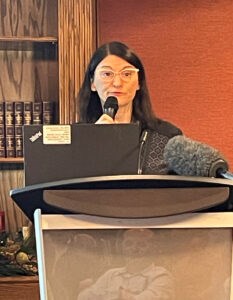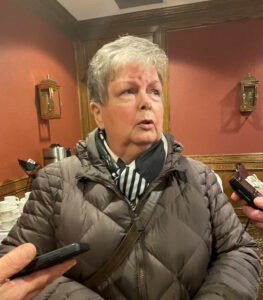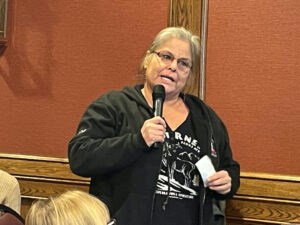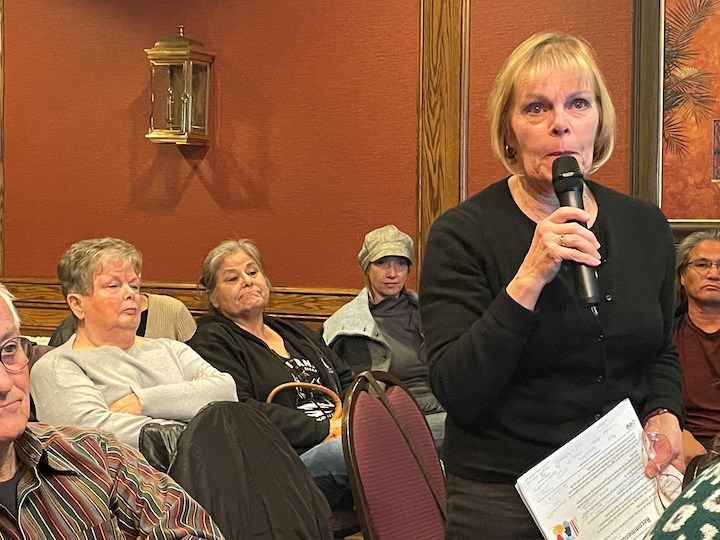New study shows increased health risks
Cathy Dobson
Now something can be done to clean up Sarnia’s air.
That was the overwhelming reaction when the results of a government study were released Wednesday that confirmed what many in the community have believed for decades.
Elevated airborne concentrations of cancer-causing benzene and sulphur dioxide exposure are increasing health risks for residents in the industrial south end of Sarnia and the Aamjiwnaang First Nation, says the study that was 16 years in the making.
Health risks, not direct health outcomes, were assessed in the study.

“We understand these are upsetting results and our hope is that they set the stage for very powerful action and that the air will be much better and much safer,” said Rachel Melzer, manager of human toxicology and air standards with the Ministry of Environment, Conservation and Parks (MECP) and the lead manager for the Sarnia Area Environmental Health Project.
Melzer called the project the most extensive study of its kind ever undertaken in Ontario. It was launched by the ministry in 2018 after a group of Sarnians known as the Lambton Community Health Study committee demanded to know if there was a link between pollutants and local health outcomes. They advocated for a study since 2007.
The MECP’s study doesn’t answer all the committee’s questions, said Melzer. But it tries to explain the risk from air pollutants.
Several members of the original health study committee were at Wednesday’s unveiling, held at the Best Western Guildwood Inn with about 45 people attending.
Sandy Kinart of Victims of Chemical Valley, which advocates for local workers, said the study is a good start to cleaning up Sarnia’s air quality.
“If this is what we need to push change, then hopefully change is going to come and it will benefit the community,” she said.

“This all just makes sense,” Kinart said. “My question is, what about the people who work at the plants?”
Kinart said she has no interest in shutting industry down but wants to make the workplace and the community safer.
“When the wind blows, we are being dosed and we don’t know with what,” she said. “We’re being dosed daily and I think we can do better in alerting (the community).”
She said better communication with the wider community is necessary when industrial incidents occur.
Coun. Anne Marie Gillis, who was also on the original health study committee, said she was pleasantly surprised that the new study has a number of recommendations that could lead to action.
“We have to be patient a little bit longer,” she said. “But we want action.”
Researchers made numerous recommendations that include more monitoring, reductions in benzene concentrations, improved ministry regulatory enforcement to reduce emissions from local industry, pollution control improvements, new government guidelines for benzene monitoring and abatement, flare minimization plans, only one flare at a time, and better communication with the First Nations and others living close to the plants.
A day prior to Wednesday’s community information meeting, members of Aamjiwnaang First Nation were provided with the study results.
Reaction from Chief Chris Plain was swift.
“Our community has not only faced health impacts from the ongoing high levels of pollution and poor air quality,” he said in a written statement. “The constant pollution has also impacted our ability to engage in traditional practices and affected our cultural relationship with the land.
“We’ve been calling for action to reduce pollution in our community for more than 100 years,” Plain said. “We need governments to take the necessary steps to ensure the standards are protective of our health and to enforce the rules in place and reduce pollution in our community.”
He called a lack of enforcement “environmental racism” and said the Assembly of First Nations will be doing an independent third-party technical review of the study’s draft report.
To do the study, the ministry looked at Sarnia’s air quality in detail between 2015 and 2019.
Melzer said the study remains relevant today, particular regarding benzene and sulphur dioxide, because researchers used air modelling and considered data from new monitoring sites in recent years.
That shows benzene risks found to be highest in northern Aamjiwnaang, were reduced after 2019 but increased again in 2023.

Spikes of benzene have been detected by a newer monitor known as the Ada Lockridge station located at the Aamjiwnaang band office on Tashmoo Avenue, Melzer said.
“The highest one-hour concentration that monitor has ever picked up over the five years that it’s been in place was in 2023,” she said. “So our feeling is that the air exposure around reducing benzene…and protecting people from those one-hour spikes continues to be relevant today.”
Sulphur dioxide tends to be “very episodic” in Sarnia, Melzer said. “It’s often driven by incidents that will produce a lot of sulphur dioxide at once, so the approach to understanding the health risks was to look at different scenarios that would cause those kinds of episodic events…and those kinds of scenarios also, unfortunately, continue to be relevant today as they were in 2019.”
A number of final ministry reports and detailed data related to Sarnia’s air quality and health risks will be released to the public in future, but no timeframe has been confirmed.
However, the report to date is available now at: https://www.cleanairsarniaandarea.com/sarnia-area-environmental-health-project/about.aspx